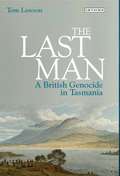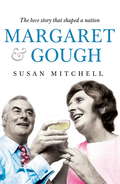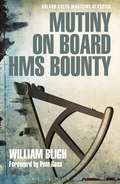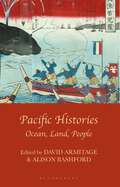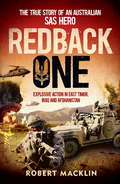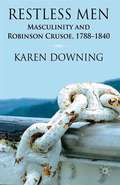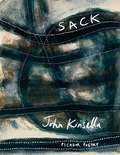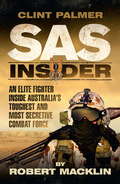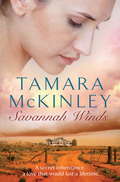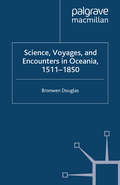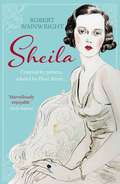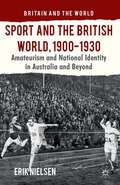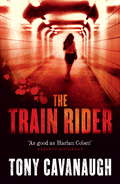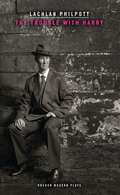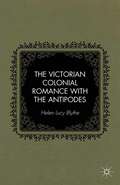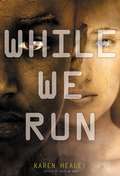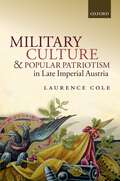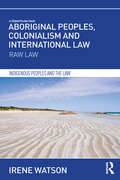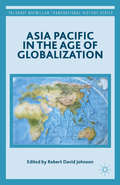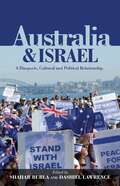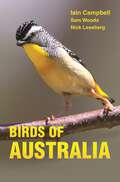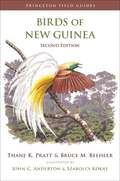- Table View
- List View
The Last Man: A British Genocide in Tasmania
by Tom LawsonLittle more than seventy years after the British settled Van Diemen's Land (later Tasmania) in 1803, its indigenous population had been virtually wiped out. Yet this genocide - one of the earliest of the modern era - is virtually forgotten in Britain today. The Last Man is the first book specifically to explore the role of the British government and wider society in the destruction of the Aboriginal Tasmanians. Although the introduction of European diseases undoubtedly contributed to the decline of the indigenous population, Tom Lawson shows that Britain supported what was effectively the ethnic cleansing of Tasmania - particularly in the period of martial law in 1828-1832. He also illustrates the ways in which the destruction of indigenous Tasmanians was reflected in British culture - both at the time and since - and how it came to play a key part in forging particular versions of British imperial identity. The Last Man provides the first comprehensive picture of Britain's role in the destruction of the Tasmanian Aboriginal population.
Margaret & Gough: The love story that shaped a nation
by Susan MitchellThe Whitlams' wasn't just a love story - it was a dynamic and enduring partnership that shaped our nation.This is the compelling story of former Prime Minister Gough Whitlam, his wife Margaret and their 70-year relationship – personal and political, private and public. It is a story of how two extraordinary people, side by side, led the Australian nation into an exciting and turbulent new era.Gough had no small talk, Margaret had the gift of easy conversation. He was often ill-at-ease in company and preferred his books. She was warm, inclusive and jollied him along. He had a vicious tongue and a quick temper. She always tried to see the best in people. He knew everything about the ideology, history and heroes of the Labor movement. She trusted her instincts. They saw each other as equals and never hesitated to express their different viewpoints. He may have passed the laws that changed the nation, but she made it possible.This is a story of love, respect, struggle, success, failure, disappointment and resilience. It was the strength and endurance of this remarkable relationship that helped change our nation politically, culturally and socially. Neither Gough nor Margaret would have developed into what each became without the influence of the other. Through every major political change, every election campaign, every triumph and every loss, they stood together.Margaret and Gough takes us inside a partnership where the political was always personal and the personal was always political.'Mitchell succeeds in weaving together their lives against a backdrop of Gough's political career ... a fine dual biography' - The Australian'This sweeping, slightly idealised overview of their love, with a bit of political history thrown into the mix, is a lesson in commitment' - Daily Telegraph'Read about Gough the man who read romantic poems from Keats and Shelley to his new wife Margaret on their honeymoon in 1942' - Sunday Territorian
Mutiny On Board HMS Bounty (Great Illustrated Classics #Vol. 19)
by William BlighOn 28th April 1789 a small and unremarkable merchant vessel became one of the most famous ships in maritime history. HMS Bounty was under the command of 34-year-old Lieutenant William Bligh, an inexperienced commander who lacked the respect of a crew attracted to the promise of an easy life in a Tahitian paradise.Fletcher Christian led half the crew in mutiny against Bligh and after overpowering all resistance, they cast their deposed captain adrift along with those still loyal to him. Luckily for Bligh, his skills as a navigator were better than his skills as a captain and he managed to sail the 23ft boat 3,618 nautical miles to Timor in the Dutch East Indies with no chart or compass, and only a quadrant and a pocket watch for navigation. On returning to England he reported what had happened, and the Royal Navy hunted down and captured most of the mutineers.However, this is only half the story – William Bligh's version. The captured mutineers went on trial and their testimonies give a much less heroic portrait of their former captain, accusing him of unduly harsh treatment. Fletcher Christian's older brother Edward, a judge, oversaw a more balanced account of the mutiny. Of the mutineers who returned to England, only three were hanged; four were acquitted and three pardoned.This book gives the fullest version of the mutiny, allowing Bligh's account to sit alongside those of his detractors. The discrepancies are fascinating, and allow us to make up our own minds about this infamous mutiny.Also includes an exclusive Foreword by former World Sailor of the Year Pete Goss, who offers a unique perspective on the trials and tribulations of the Bounty's crew, whether castaway or mutineer.
Pacific Histories: Ocean, Land, People
by David Armitage Alison BashfordThe first comprehensive account to place the Pacific Islands, the Pacific Rim and the Pacific Ocean into the perspective of world history. A distinguished international team of historians provides a multidimensional account of the Pacific, its inhabitants and the lands within and around it over 50,000 years, with special attention to the peoples of Oceania. It providing chronological coverage along with analyses of themes such as the environment, migration and the economy; religion, law and science; race, gender and politics.
Redback One: The true story of an Australian SAS hero (Hachette Military Collection)
by Robert MacklinExplosive SAS action in East Timor, Iraq and Afghanistan.The command came: 'Stop those vehicles!'It was like a red rag to a bull. Instantly streams of 7.62 mm tracer and 50 mm calibre machine gun rounds arced across the night sky and smashed into the bus and truck.Elite SAS Patrol Commander Stuart 'Nev' Bonner takes us inside the extraordinary and dangerous world of secret combat operations in this explosive, behind-the-scenes look at life inside the SAS. A world where capture means torture or death, and every move is trained for with precision detail to bring elite soldiers to the very peak of fighting ability.In a career spanning twenty years, fourteen of them in the SAS, Bonner shares with us the inside story of being out in front – and often behind enemy lines.From patrolling the mountains of East Timor to covert operations in Bougainville and the Solomon Islands, from sweeping into the Iraqi desert ahead of invading US forces to cripple Saddam Hussein's communications to patrolling in war-torn Baghdad and being in the middle of the disastrous Operation Anaconda in Afghanistan – this is a no holds barred account of what it like to live, eat and breathe SAS.
Restless Men: Masculinity and Robinson Crusoe, 1788-1840
by K. DowningRobinson Crusoe's call to adventure and do-it-yourself settlement resonated with British explorers. In tracing the links in a discursive chain through which a particular male subjectivity was forged, Karen Downing reveals how such men took their tensions with them to Australia, so that the colonies never were a solution to restless men's anxieties.
Sack
by John KinsellaIn John Kinsella's new collection, 'Sack' not only refers not only to the shocking title poem, where a tied, writhing sack is seen flung from a car into gully - but also to the sacking and exploitation of the landscape and those who labour on it. Kinsella draws vividly on 'childhood memories' - but reveals them for the hard truths they are, by subtracting the cushioning effects of nostalgia. Kinsella shows how childhood prefigures our adult experience, and how its residues (here, those also take the literal form of asbestos and radiation) influence and shape our futures. Elsewhere, Kinsella resurrects an old form to do new work: the 'penillion' is an old Welsh stanza whose concision and insistent musicality provide the ideal means to encapsulate and concentrate Kinsella's vision of the land, animal life, and our sometimes fraught relationship with both. These short poems reveal astonishing and unsuspected correlations between music and form, place and language - and will come as a delightful surprise to those who know Kinsella primarily as a freewheeling long-form poet. But throughout Sack, the articulate urgency of Kinsella's lyric builds to nothing so much as a call to action, and underlines John Kinsella's reputation as one of the greatest Australian poets of the last fifty years.
SAS Insider: An elite SAS fighter on life in Australia's toughest and most secretive combat unit (Hachette Military Collection #3)
by Clint Palmer Robert MacklinThe true story of Australia's SAS and the soldier who was there from the start.Clint Palmer has spent much of his adult life in the SAS and has fought in this elite military unit as it developed from its fledgling beginnings into the highly trained, specialised fighting force it is today. He is an insider with the long view and this is his unique story of life in the SAS.As a bush kid in the Northern Territory of Australia, growing up in a one dog mining town, Palmer's best friends were mostly Aboriginal kids, and the outside world barely existed. But he always had one driving ambition - the army. Enduring the toughest of tough training, Palmer soon demonstrated his fighting capabilities and became part of the Australian SAS. So began almost thirty years of service.We go with him to Iraq and Afghanistan, where he is at the heart of some of the worst fighting in Operation Anaconda in the Shahi-Kot Valley in 2002. He lets us in on what it's like to have made well over a thousand parachute jumps, many of them in terrible conditions and into treacherous terrain which may have ended not just his career but his life. And he shares with us how this adrenalin fuelled world has become a lifelong commitment.Palmer is the man who knows the Regiment almost better than anyone, so SAS Insider really is the inside story of the SAS - and a gripping account of one Australian soldier's life at the sharp end.Robert Macklin is a well-known Australian biographer and historian with more than twenty books to his credit. His most recent books include One False Move, Dark Paradise and the bestselling SAS Sniper which he co-wrote with Rob Maylor.
Savannah Winds
by Tamara McKinleyWhen Fleur receives word of a surprise inheritance from an aunt she never knew, it couldn't come at a more opportune moment. Her relationship is crumbling, and she's caught in the middle of a serious family rift. Consulting her aunt's long-lost diary, Fleur sets out on a voyage of historical discovery up the coast and through the Gulf Country, to the isolated cattle ranch Savannah Winds. But unbeknownst to Fleur, what she uncovers there could have devastating repercussions for her own life. Set between the 1930s and the modern day, Savannah Winds is an exploration of family ties, bitter rivalry and the strength of enduring love.
Science, Voyages, and Encounters in Oceania, 1511-1850 (Palgrave Studies in Pacific History)
by Bronwen DouglasBlending global scope with local depth, this book throws new light on important themes. Spanning four centuries and vast space, it combines the history of ideas with particular histories of encounters between European voyagers and Indigenous people in Oceania (Island Southeast Asia, New Guinea, Australia, New Zealand, and the Pacific Islands).
Sheila: The Australian ingenue who bewitched British society
by Robert WainwrightVivacious, confident and striking, young Australian Sheila Chisholm met her first husband, Lord Loughborough, in Egypt during the First World War. Arriving in London as a young married woman, she quickly conquered English society, and would spend the next half a century inside the palaces, mansions and clubs of the elite. Her clandestine affair with young Bertie, the future George VI, caused ruptures at Buckingham Palace, with King George offering his son the title Duke of York in exchange for never hearing of Sheila again.She subsequently became Lady Milbanke, one of London's most admired fashion icons and society fundraisers and ended her days as Princess Dimitri of Russia, juggling her royal duties with a successful career as a travel agent. Throughout her remarkable life, Sheila won the hearts of men ranging from Rudolph Valentino and Vincent Astor to Prince Obolensky, and maintained longstanding friendships with Evelyn Waugh, Noël Coward, Idina Sackville and Nancy Mitford.A story unknown to most, Sheila is a spellbinding account of an utterly fascinating woman.
Sport and the British World, 1900-1930: Amateurism and National Identity in Australasia and Beyond (Britain and the World)
by E. NielsenThis book provides a lively study of the role that Australians and New Zealanders played in defining the British sporting concept of amateurism. In doing so, they contributed to understandings of wider British identity across the sporting world.
The Train Rider (The Darian Richards Series #3)
by Tony Cavanaugh'Tony Cavanaugh brings new depth and dimension to crime fiction in this country' - The Weekend WestOne man pushed Darian Richards to the edge. The man he couldn't catch. The Train Rider.As Victoria's top homicide investigator, Darian Richards spent years catching killers. The crimes of passion, of anger, of revenge ... they were easy. It was the monsters who were hard.Someone was taking girls. At first he'd keep them a week then give them back. Darian warned that wouldn't last. It didn't. From then on, their bodies were never found. Girls kept disappearing. All they had in common was the fact they'd last been seen on a train.The ever-rising list of the vanished broke Darian. Forced him to walk away. Now, retired, watching the Noosa River flow by, the nightmares had finally stopped. Darian was never going back.Then three girls go missing from Queensland trains. Darian knows that the killer is playing him. He has a choice to make. But when the decision means a girl will die, there is no choice. He has to stop this man once and for all. Forever.Tony Cavanaugh is an Australian writer and producer of film and television. The Train Rider is his latest book featuring cop Darian Richards and follows on from the acclaimed crime thrillers Promise and Dead Girl Sing.The Darian Richards SeriesPromiseDead Girl Sing The Soft Touch (Short Story) The Train Rider Kingdom of the Strong
The Trouble with Harry (Oberon Modern Plays)
by Lachlan PhilpottHarry Crawford and his wife Annie seem happy enough. Together they lead quiet, unexceptional lives in the suburbs of 1920s Sydney, working and raising a child. But when Josephine arrives at the door, it sets in train a series of events that will result in an astounding revelation. Based on the extraordinary true story of the ‘Man-Woman’ murder that shocked turn-of-the-century Australians, The Trouble with Harry is a disorienting tale of deception and enigma which poses an essential, human question: can we ever really know what lies in the heart and mind of someone else?
The Victorian Colonial Romance with the Antipodes
by H. BlytheThis study treats the Victorian Antipodes as a compelling site of romance and satire for middle-class writers who went to New Zealand between 1840 and 1872. Blythe's research fits with the rising study of settler colonialism and highlights the intersection of late-Victorian ideas and post-colonial theories.
While We Run
by Karen HealeyIt's 2127, and the future is at stake . . . Abdi Taalib thought he was moving to Australia for a music scholarship. But after meeting the beautiful and brazen Tegan Oglietti, his world was turned upside down. Tegan's no ordinary girl - she died in 2027, only to be frozen and brought back to life in Abdi's time, 100 years later. Now, all they want is for things to return to normal (or as normal as they can be), but the government has other ideas. Especially since the two just spilled the secrets behind Australia's cryonics project to the world. On the run, Abdi and Tegan have no idea who they can trust - and, when they uncover startling new details about the program, they realize that thousands of lives may be in their hands. Karen Healey offers a suspenseful, page-turning companion to When We Wake that will keep readers on the edge of their seats and make them call into question their own ideas about morality -- and mortality, too.
Military Culture And Popular Patriotism In Late Imperial Austria
by Laurence ColeMilitary Culture and Popular Patriotism in Late Imperial Austria examines the interplay between popular patriotism and military culture in late imperial Austria. Laurence Cole suggests that two main questions should be asked regarding the western half of the Habsburg Monarchy during the period from the mid-nineteenth century to the outbreak of war in 1914. Firstly, how far did imperial Austrian society experience a process of militarization comparable to that of other European countries? Secondly, how far did the military sphere foster popular patriotism in the multinational state? Various manifestations of military culture, including hero cults and, above all, military veterans associations, provide the main subject for analysis in this volume. After exploring the historical development of military culture in the Habsburg Monarchy, Cole explains how the long reign of Emperor Franz Joseph I constituted a decisive phase in the militarization of Austrian society, with the dynasty and state emphasizing the military's role as the locus of loyalty. Popular manifestations of military culture, such as the hero cult surrounding Field Marshal Radetzky and military veterans associations, complemented the official agenda in many respects. However, veterans associations in particular constituted a political mobilization of the lower middle and lower classes, who asserted their own interests and position in civil society, as is shown by case studies of regions of the Austrian state with significant Italian-speaking populations (Trentino and the Littoral). State attempts to assert greater control of veterans activities led to national and political opposition at a time when tensions over 'militarism' and foreign policy increased. Military Culture and Popular Patriotism in Late Imperial Austria thus raises the question of whether the military was really a bulwark of the multinational state or rather a polarizing force in imperial Austrian society.
Aboriginal Peoples, Colonialism and International Law: Raw Law (Indigenous Peoples and the Law)
by Irene WatsonThis work is the first to assess the legality and impact of colonisation from the viewpoint of Aboriginal law, rather than from that of the dominant Western legal tradition. It begins by outlining the Aboriginal legal system as it is embedded in Aboriginal people’s complex relationship with their ancestral lands. This is Raw Law: a natural system of obligations and benefits, flowing from an Aboriginal ontology. This book places Raw Law at the centre of an analysis of colonisation – thereby decentring the usual analytical tendency to privilege the dominant structures and concepts of Western law. From the perspective of Aboriginal law, colonisation was a violation of the code of political and social conduct embodied in Raw Law. Its effects were damaging. It forced Aboriginal peoples to violate their own principles of natural responsibility to self, community, country and future existence. But this book is not simply a work of mourning. Most profoundly, it is a celebration of the resilience of Aboriginal ways, and a call for these to be recognised as central in discussions of colonial and postcolonial legality. Written by an experienced legal practitioner, scholar and political activist, AboriginalPeoples, Colonialism and International Law: Raw Law will be of interest to students and researchers of Indigenous Peoples Rights, International Law and Critical Legal Theory.
Aboriginal Peoples, Colonialism and International Law: Raw Law (Indigenous Peoples and the Law)
by Irene WatsonThis work is the first to assess the legality and impact of colonisation from the viewpoint of Aboriginal law, rather than from that of the dominant Western legal tradition. It begins by outlining the Aboriginal legal system as it is embedded in Aboriginal people’s complex relationship with their ancestral lands. This is Raw Law: a natural system of obligations and benefits, flowing from an Aboriginal ontology. This book places Raw Law at the centre of an analysis of colonisation – thereby decentring the usual analytical tendency to privilege the dominant structures and concepts of Western law. From the perspective of Aboriginal law, colonisation was a violation of the code of political and social conduct embodied in Raw Law. Its effects were damaging. It forced Aboriginal peoples to violate their own principles of natural responsibility to self, community, country and future existence. But this book is not simply a work of mourning. Most profoundly, it is a celebration of the resilience of Aboriginal ways, and a call for these to be recognised as central in discussions of colonial and postcolonial legality. Written by an experienced legal practitioner, scholar and political activist, AboriginalPeoples, Colonialism and International Law: Raw Law will be of interest to students and researchers of Indigenous Peoples Rights, International Law and Critical Legal Theory.
Asia Pacific in the Age of Globalization (Palgrave Macmillan Transnational History Series)
by Robert David JohnsonThe essays in this volume examine United States-East Asian relations in the framework of global history, incorporating fresh insights that have been offered by scholars on such topics as globalization, human rights, historical memory, and trans-cultural relations.
Australia & Israel: A Diasporic, Cultural and Political Relationship
by Burla, Shahar; Lawrence, DashielAustralia and the State of Israel have maintained a cordial if at times ambiguous relationship. The two countries are geographically isolated: strategic, economic and cultural interests lie increasingly with Asia for one, and with the US and the EU for the other. But for all that divides the two states, there is also much they share. Australia played an important role in the Jewish state's establishment in 1948, and is home to the most Zionist centered Jewish diaspora globally. Jewishness for most Australian Jews has been shaped and defined by engagement with and support for Israel. At the heart of this engagement is a small but thriving Israeli community within the larger multicultural Australia. Australia and Israel: A Diasporic, Cultural and Political relationship draws attention to the important historical and contemporary nexus between this diaspora and its imagined homeland. The collection also considers the ways in which these two states mobilise national myths and share environmental challenges. In recent time relations between the two states have been tested by the illegal use of Australian passports in 2010, the mysterious death of dual national Ben Zygier, and growing disquiet within the ranks of the Australian Labor Party and the Australian Greens over Israel's handling of the Israel-Palestinian conflict. One prominent world-wide issue is the Palestinian BDS (Boycotts, Divestments and Sanctions) movement, which has attracted sympathy and support that has brought about substantive differences of opinion regarding its legitimacy within the Jewish Australian community. These issues demonstrate the multifaceted and complex picture of two very different nations, that nevertheless share an abiding connection.
Birds of Australia: A Photographic Guide
by Iain Campbell Sam Woods Nick Leseberg Geoff JonesAustralia is home to a spectacular diversity of birdlife, from parrots and penguins to emus and vibrant passerines. Birds of Australia covers all 714 species of resident birds and regularly occurring migrants and features more than 1,100 stunning color photographs, including many photos of subspecies and plumage variations never before seen in a field guide. Detailed facing-page species accounts describe key identification features such as size, plumage, distribution, behavior, and voice. This one-of-a-kind guide also provides extensive habitat descriptions with a large number of accompanying photos. The text relies on the very latest IOC taxonomy and the distribution maps incorporate the most current mapping data, making this the most up-to-date guide to Australian birds.Covers all 714 species of resident birds and regularly occurring migrantsFeatures more than 1,100 stunning color photosIncludes facing-page species accounts, habitat descriptions, and distribution mapsThe ideal photographic guide for beginners and seasoned birders alike
Birds of Australia: A Photographic Guide (PDF)
by Iain Campbell Sam Woods Nick Leseberg Geoff JonesAustralia is home to a spectacular diversity of birdlife, from parrots and penguins to emus and vibrant passerines. Birds of Australia covers all 714 species of resident birds and regularly occurring migrants and features more than 1,100 stunning color photographs, including many photos of subspecies and plumage variations never before seen in a field guide. Detailed facing-page species accounts describe key identification features such as size, plumage, distribution, behavior, and voice. This one-of-a-kind guide also provides extensive habitat descriptions with a large number of accompanying photos. The text relies on the very latest IOC taxonomy and the distribution maps incorporate the most current mapping data, making this the most up-to-date guide to Australian birds.Covers all 714 species of resident birds and regularly occurring migrantsFeatures more than 1,100 stunning color photosIncludes facing-page species accounts, habitat descriptions, and distribution mapsThe ideal photographic guide for beginners and seasoned birders alike
Birds of New Guinea: Second Edition
by Thane K. Pratt Bruce M. Beehler John C. Anderton Szabolcs KókayThis is the completely revised edition of the essential field guide to the birds of New Guinea. The world's largest tropical island, New Guinea boasts a spectacular avifauna characterized by cassowaries, megapodes, pigeons, parrots, cuckoos, kingfishers, and owlet-nightjars, as well as an exceptionally diverse assemblage of songbirds such as the iconic birds of paradise and bowerbirds. Birds of New Guinea is the only guide to cover all 780 bird species reported in the area, including 366 endemics. Expanding its coverage with 111 vibrant color plates—twice as many as the first edition—and the addition of 635 range maps, the book also contains updated species accounts with new information about identification, voice, habits, and range. A must-have for everyone from ecotourists to field researchers, Birds of New Guinea remains an indispensable guide to the diverse birds of this remarkable region.780 bird species, including 366 found nowhere else111 stunning color plates, twice the number of the first editionExpanded and updated species accounts provide details on identification, voice, habits, and range635 range mapsRevised classification of birds reflects the latest research
Birds of New Guinea: Second Edition (PDF)
by Thane K. Pratt Bruce M. Beehler John C. Anderton Szabolcs KókayThis is the completely revised edition of the essential field guide to the birds of New Guinea. The world's largest tropical island, New Guinea boasts a spectacular avifauna characterized by cassowaries, megapodes, pigeons, parrots, cuckoos, kingfishers, and owlet-nightjars, as well as an exceptionally diverse assemblage of songbirds such as the iconic birds of paradise and bowerbirds. Birds of New Guinea is the only guide to cover all 780 bird species reported in the area, including 366 endemics. Expanding its coverage with 111 vibrant color plates—twice as many as the first edition—and the addition of 635 range maps, the book also contains updated species accounts with new information about identification, voice, habits, and range. A must-have for everyone from ecotourists to field researchers, Birds of New Guinea remains an indispensable guide to the diverse birds of this remarkable region.780 bird species, including 366 found nowhere else111 stunning color plates, twice the number of the first editionExpanded and updated species accounts provide details on identification, voice, habits, and range635 range mapsRevised classification of birds reflects the latest research
